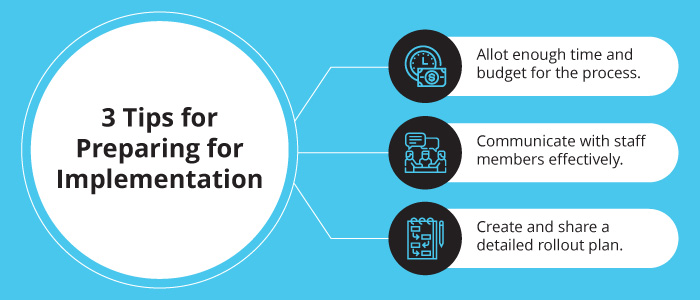
This could be your association’s reality, but you’ll need to make some changes to get there. Most associations need to upgrade or change their association management software (AMS) to align with evolving needs and goals, but technology implementations can feel daunting.
However, adopting new technology doesn’t have to be complicated. This guide will walk through a few strategies your association can follow to make the process run smoothly, beginning with understanding your needs. Let’s get started!
The goal of a needs assessment is to identify the gaps between your current solution’s performance and the functionality you need to accomplish your goals. Typically, these assessments include an evaluation of your current technology, required features for the new software, budgetary constraints, a desired implementation timeline, and a risk assessment.
Protech’s guide to association management software highlights an example of this in which the fictional association identifies a gap in its recruitment strategy (staff members have to manually send renewal reminders). To remedy this gap, invest in an AMS that automates these reminders instead.
While this step should occur long before you start implementing new technology, it serves as the foundation for the technology adoption process. Specifically, your needs assessment reveals:
Taking this important step will ensure that you implement the right technology that aligns with your association’s needs while mitigating risks and optimizing your available resources. This prepares your association to leverage all the exciting features your new tool offers, from enhancing member engagement to executing seamless virtual events.
Your staff members interact with your association management tools daily, so it’s critical that they understand how to get the most out of the technology. To get them ready for the transition to new or upgraded software, be sure to:

By properly planning for and communicating about this process, your staff will experience a smooth transition between old and new technology. This ensures they are excited to learn about the new tools available to them and how best to use them to your association’s advantage.
Implementing new technology changes the experiences and workflows of everyone involved with your association, from staff to stakeholders to members. Because the impact of changing software can be so significant and, in some cases, complex, it might be best to work with an experienced consultant.
When looking for a consultant, do your due diligence to find one who is qualified, familiar with your industry, and willing to complete the job to your satisfaction. Fionta’s guide to selecting a tech consultant recommends researching qualified professionals, checking recommendations and references to identify reliable consultants. Additionally, aim to look for a long-term partnership and aim to focus on more than just the cost of a consultant. Think of these partnerships as long-term investments that will pay off in the long run.
Additionally, the implementation partner you choose should be certified to assist with implementing, integrating, configuring, and supporting the software your association uses. If you are using a Salesforce-based platform, for example, research certified Salesforce partners with high AppExchange ratings and a robust portfolio showcasing past clients.
For many associations, implementing new technology is a necessary stepping stone in their journeys. It will enable your organization to do much more for its members, from providing continuing education opportunities to organizing exciting events to significantly improving communication. And by using the right strategies and recruiting implementation support from experts, you’ll ensure a smooth transition to scalable, sustainable technology.
Erin Lemons, Senior Marketing Director at Fonteva
Erin Lemons joins Togetherwork Association Solutions with over 15 years serving as a marketing director, event producer, and project manager creating robust marketing campaigns and initiatives that focus on the growing and ever-changing technology needs of the association industry. She leads the marketing teams and strategy at Fonteva and Protech.

Path LMS is used by hundreds of organizations to deliver high-quality online learning, networking events, and conferences. Book a demo today!